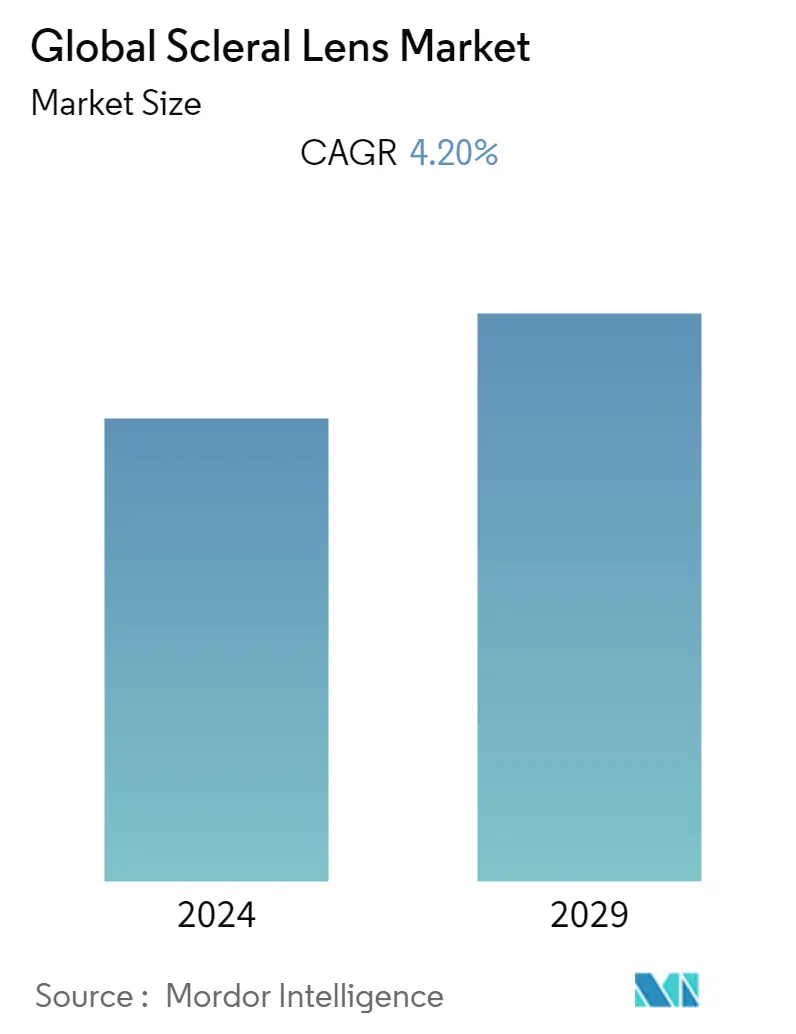Market Size of Global Scleral Lens Industry

| Study Period | 2019 - 2029 |
| Base Year For Estimation | 2023 |
| CAGR | 4.20 % |
| Fastest Growing Market | Asia-Pacific |
| Largest Market | North America |
| Market Concentration | High |
Major Players
*Disclaimer: Major Players sorted in no particular order |
Scleral Lens Market Analysis
The scleral lens market is expected to register a CAGR of 4.2% over the forecast period, 2022-2027.
The emergence of the COVID-19 pandemic harmed the world economy and the healthcare system. The lockdown around the globe has affected the supply chain of pharmaceuticals, medical devices, and biotechnological products. On the other hand, R&D has come into focus. All the government agencies and healthcare players have come forward to support the development of diagnostics and treatment methods for COVID-19. In the case of scleral lenses, a survey conducted by Euro lens Research (University of Manchester) in April 2020 found that 75% of scleral lens wearers reported reductions in the use of these lenses due to lockdowns and the limited supply of daily/weekly-wear lenses. Furthermore, the major market players, such as Bausch + Lomb, Visionary Optics & AccuLens, showed declining sales owing to decreased operations. This led prominent as well as emerging companies to change their business strategies to adapt. Thus, the scleral lens market shows a negative growth impact in pandemic due to a continuous decrease in sales of the key players.
Scleral lenses are used to correct vision defects such as myopia, irregular cornea, ocular surface disease, refractive error, hyperopia, astigmatism, and presbyopia. The increase in the prevalence of this disease is expected to drive the scleral lens market over the forecast period. As per the World Health Organization, the prevalence of myopia is highest in East Asian countries such as Japan, South Korea, a, and Singapore. As per the National Center for Biotechnology Information article published in 2019, by 2050, myopia and high myopia are both expected to affect ~4,949 million and ~925 million people, respectively, globally. The growing cases of myopia and increasing spending on ophthalmic products, such as scleral lenses, as a corrective measure for refractive errors, are expected to drive the growth of the scleral lenses market in the future.
With a huge population base, developing countries worldwide, including Mexico, BRIC, India, China and South Africa, offers potential growth opportunities for contact lens manufacturers. As China and India has the highest population as compared to other countries; this countries are generating need for scleral wear due to increasing eye defects owing to the increasing geriatric population in the region. The geriatric population is estimated to increase from 548 million in 2019 to nearly 1.3 billion by 2050, that would drive the prevalence of age-related eye diseases in the region. Rising awareness of eye disorders, changing lifestyles, growing per capita spending, and market saturation in emerging economies are also encouraging market players to expand their presence in these emerging economies.
Therefore, owing to the aforementioned factors the studied market is anticipated to witness growth over the analysis period. However, careless usage could harm eyesight and a lack of well-equipped practitioners are likely to impede the market growth.
Scleral Lens Industry Segmentation
Scleral contacts are large-diameter gas permeable contact lenses specially designed to vault over the entire corneal surface and rest on the sclera. These lenses functionally replace the irregular cornea with a perfectly smooth optical surface to correct vision problems caused by keratoconus and other corneal irregularities. The scleral lens market is segmented by Type (Corneo-Scleral Lenses and Semi-Scleral Lenses, Mini-Scleral Lenses, and Full Scleral Lenses), Application (Irregular Cornea, Ocular Surface Disease, Refractive Error, and Other Applications), End User (Hospitals, Eye Clinics, and Other End Users), and Geography (North America, Europe, Asia-Pacific and Rest of World). The report offers the value (in USD million) for the above segments.
| By Type | |
| Corneo-scleral and Semi-scleral Lenses | |
| Mini-Scleral Lenses | |
| Full Scleral Lenses |
| By Application | |
| Irregular Cornea | |
| Ocular Surface Disease | |
| Refractive Error | |
| Other Applications |
| By End User | |
| Hospitals | |
| Eye Clinics | |
| Other End Users |
| Geography | ||||||||
| ||||||||
| ||||||||
| ||||||||
| Rest of World |
Global Scleral Lens Market Size Summary
The scleral lens market is poised for growth, driven by the increasing prevalence of vision defects such as myopia, astigmatism, and presbyopia. These lenses are essential for correcting refractive errors and are gaining traction due to the rising cases of ocular surface diseases and age-related eye conditions. The market experienced a downturn during the COVID-19 pandemic, with significant disruptions in supply chains and reduced lens usage among wearers. However, the focus on research and development, along with strategic adaptations by key players, has set the stage for recovery and expansion. Developing regions, particularly in Asia and Africa, present substantial growth opportunities due to their large populations and increasing demand for ophthalmic products. The geriatric population's growth in these areas further fuels the need for scleral lenses, as age-related eye diseases become more prevalent.
North America is expected to dominate the global scleral lens market, with the United States leading due to its high prevalence of eye diseases and ongoing advancements in ophthalmic research and development. The market is characterized by intense competition among major players such as Bausch Health Companies Inc., Visionary Optics, and CooperVision, who are actively launching innovative products and forming strategic partnerships to enhance their market presence. The corneo-scleral and semi-scleral lenses segment is particularly significant, offering comfort and acuity benefits that cater to a broad range of users, including those with severe dry eyes and post-corneal transplant patients. Despite challenges like careless usage and a shortage of well-equipped practitioners, the market is expected to grow, supported by increasing awareness of eye disorders and rising per capita spending on eye care.
Global Scleral Lens Market Size - Table of Contents
-
1. MARKET DYNAMICS
-
1.1 Market Overview
-
1.2 Market Drivers
-
1.2.1 Growing Number of Ophthalmic Patients
-
1.2.2 Increasing Adoption of Scleral Lenses across the Globe
-
-
1.3 Market Restraints
-
1.3.1 Availability of Alternative Techniques
-
-
1.4 Porter's Five Force Analysis
-
1.4.1 Threat of New Entrants
-
1.4.2 Bargaining Power of Buyers/Consumers
-
1.4.3 Bargaining Power of Suppliers
-
1.4.4 Threat of Substitute Products
-
1.4.5 Intensity of Competitive Rivalry
-
-
-
2. MARKET SEGMENTATION (Market Size by Value - USD million)
-
2.1 By Type
-
2.1.1 Corneo-scleral and Semi-scleral Lenses
-
2.1.2 Mini-Scleral Lenses
-
2.1.3 Full Scleral Lenses
-
-
2.2 By Application
-
2.2.1 Irregular Cornea
-
2.2.2 Ocular Surface Disease
-
2.2.3 Refractive Error
-
2.2.4 Other Applications
-
-
2.3 By End User
-
2.3.1 Hospitals
-
2.3.2 Eye Clinics
-
2.3.3 Other End Users
-
-
2.4 Geography
-
2.4.1 North America
-
2.4.1.1 United States
-
2.4.1.2 Canada
-
2.4.1.3 Mexico
-
-
2.4.2 Europe
-
2.4.2.1 Germany
-
2.4.2.2 United Kingdom
-
2.4.2.3 France
-
2.4.2.4 Italy
-
2.4.2.5 Spain
-
2.4.2.6 Rest of Europe
-
-
2.4.3 Asia-Pacific
-
2.4.3.1 China
-
2.4.3.2 Japan
-
2.4.3.3 India
-
2.4.3.4 Australia
-
2.4.3.5 South Korea
-
2.4.3.6 Rest of Asia-Pacific
-
-
2.4.4 Rest of World
-
-
Global Scleral Lens Market Size FAQs
What is the current Global Scleral Lens Market size?
The Global Scleral Lens Market is projected to register a CAGR of 4.20% during the forecast period (2024-2029)
Who are the key players in Global Scleral Lens Market?
Visionary Optics, Essilor, ABB Optical Group, Bausch Health Companies Inc. and Art Optical Contact Lens, Inc. are the major companies operating in the Global Scleral Lens Market.

